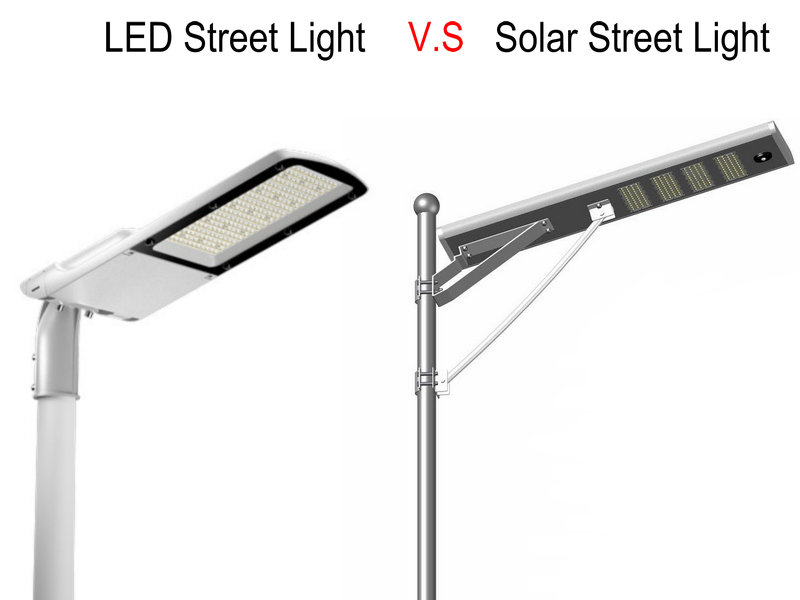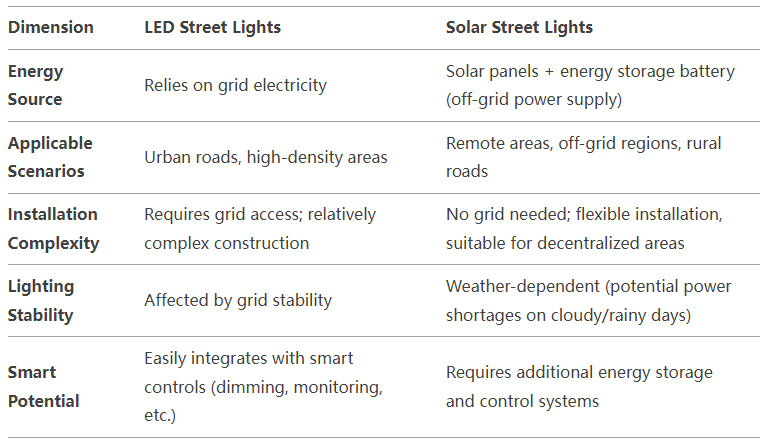Which is more favored in the market, LED street lights or solar street lights?
2025-02-14
Which is more favored in the market, LED street lights or solar street lights?

The market favorability of LED street lights and solar street lights is influenced by multiple factors, including application scenarios, regional resources, policy support, cost-effectiveness, and technological maturity. The following is a comparison analysis and summary of market trends for both:
1. Technical Features Comparison

2. Key Factors Influencing Market Preference
(1) Regional Demand Differences
*Urban and Developed Areas:
>LED street lights dominate: Urban grids are well-established, with a focus on energy efficiency and smart management (e.g., dimming, IoT integration).
>Case study: European and American countries are replacing traditional sodium lamps with LED street lights on a large scale and upgrading to "smart poles" (integrated with 5G, monitoring, etc.).
*Rural and Off-Grid Areas:
>Solar street lights are more popular: No need for grid coverage, making them suitable for areas with weak power infrastructure.
>Case study: Rural areas in Africa and India are addressing lighting issues with solar street lights, and China’s "Photovoltaic Poverty Alleviation" project promotes solar street lights.
(2) Cost-Benefit Analysis
*Initial Investment:
>LED street lights: Lower per-unit cost but requires grid modification expenses (especially in older urban areas).
>Solar street lights: Higher per-unit cost (including solar panels and batteries) but eliminates grid installation costs.
*Long-Term Operation:
>LED street lights: Low electricity and maintenance costs (lifespan over 50,000 hours).
>Solar street lights: Zero electricity costs, but limited battery lifespan (3-5 years, increasing maintenance costs).
(3) Policy Drivers
*LED Street Lights:
Driven by "carbon neutrality" policies (e.g., EU’s 2030 phase-out of high-energy-consuming street lights).
Subsidies for urban smart projects (e.g., China’s "New Infrastructure" supporting smart poles).
*Solar Street Lights:
Energy poverty alleviation policies in developing countries (e.g., India’s "Solar Urja Lamp" initiative).
Renewable energy subsidies for remote areas (e.g., Africa’s off-grid solar initiatives).
(4) Technical Challenges and Innovations
LED Street Light Pain Points: Heat dissipation in extreme temperatures, light decay control.
Solar Street Light Pain Points: Short battery lifespan, insufficient power supply on cloudy/rainy days.
Integration Trends:
Solar LED street lights: Combining the advantages of both, emerging as a new solution (e.g., China’s rural promotion of integrated "PV + LED" street lights).
Hybrid energy systems: Solar + wind complementary power supply to enhance stability.
3. Global Market Data and Trends
*LED Street Light Market:
Global market size in 2023: approximately $12 billion, with an annual growth rate of 8% (Statista data), driven mainly by urban renovation and smart lighting demand.
China accounts for over 60% of global production, while Europe and America push high-value-added smart street lights.
*Solar Street Light Market:
Market size in 2023: approximately $4.5 billion, with an annual growth rate of 12% (Grand View Research data), driven by strong demand in Africa and Southeast Asia.
Technological advancements are reducing costs (e.g., lithium batteries replacing lead-acid batteries, extending lifespan by 30%).
4. Future Trends
*Scenario Differentiation:
Cities will focus on smart LED street lights (energy-saving + data management), while rural/off-grid areas will rely on solar street lights.
*Technology Integration:
Integrated systems of "solar + LED + energy storage + smart control" to enhance overall energy efficiency.
*Policy Orientation:
Developed countries emphasize the carbon neutrality contribution of LED street lights, while developing countries achieve energy equity through solar street lights.
Conclusion: Which is More Preferred?
Urban and grid-covered areas: LED street lights remain mainstream (low cost, easy to smarten).
Remote and off-grid areas: Solar street lights are irreplaceable (strong demand).
Emerging growth point: The integration of both, "solar LED street lights," has huge potential in transitional urban-rural areas and emerging markets.
The final answer depends on specific demand scenarios, but the overall market shows a trend of "complementary coexistence and technological integration."




